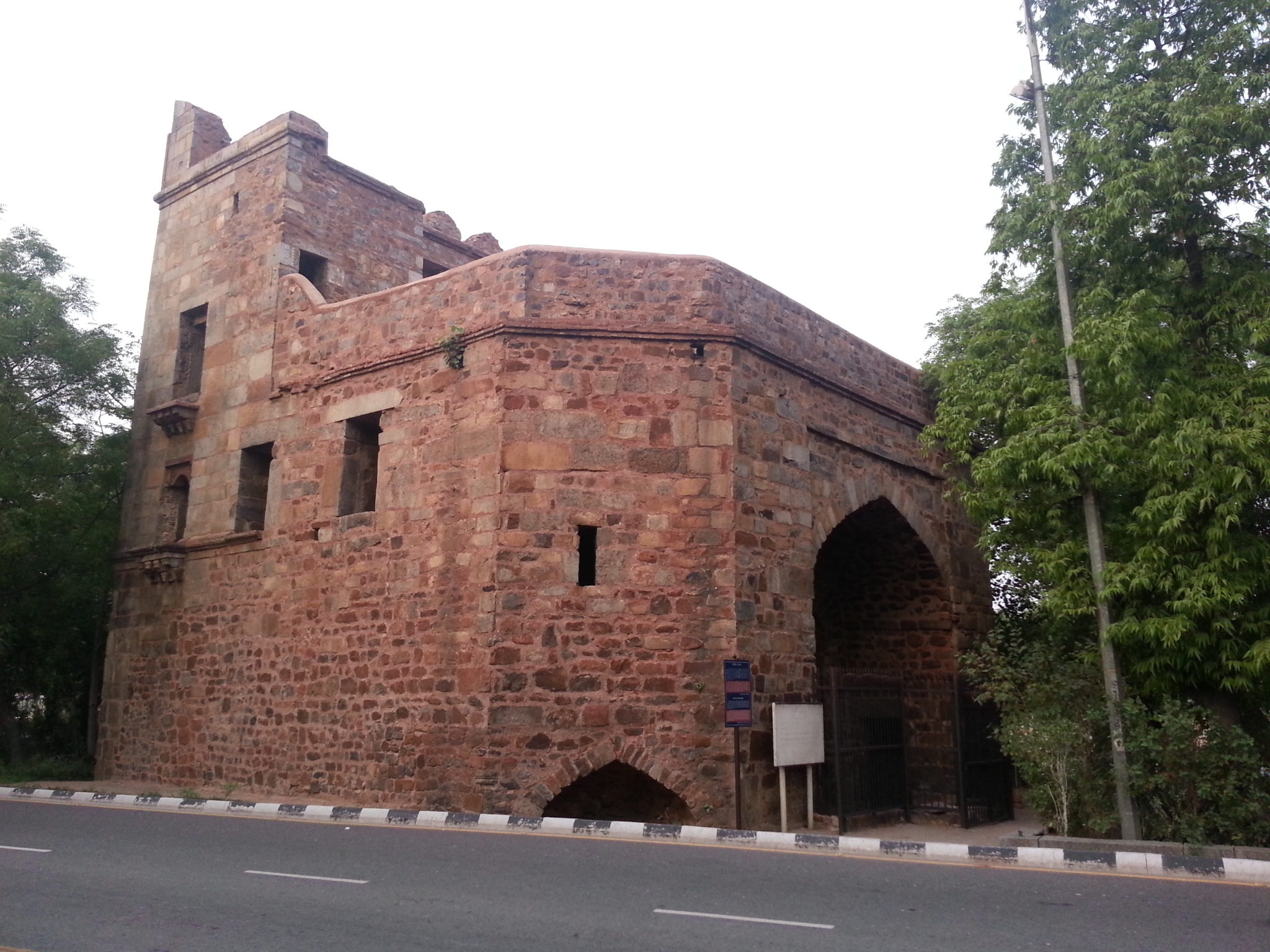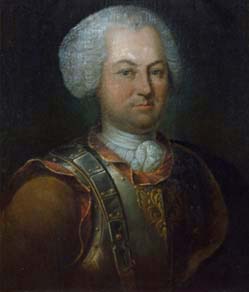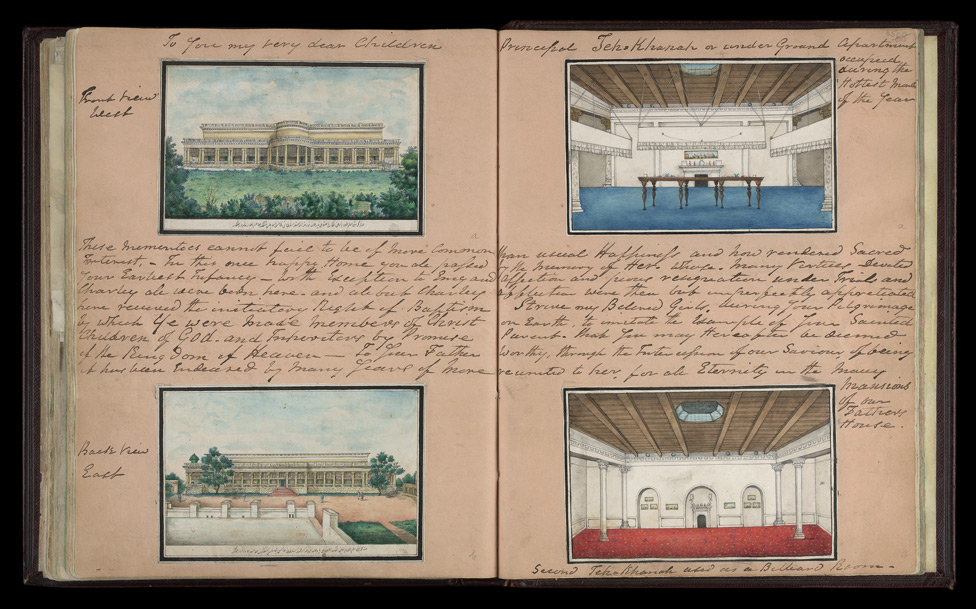|
Battle Of Najafgarh
The Battle of Najafgarh was a subsidiary engagement of the Siege of Delhi during the Indian Rebellion of 1857. A large Indian force sortied from Delhi, intending to attack the rear of the British force besieging the city. A detachment from the besiegers marched to intercept them, and defeated them while they were disordered by difficult terrain and by quarrels among their commanders. Siege of Delhi During the earliest days of the Rebellion, sepoys (Indian soldiers) of the British East India Company's Bengal Army stationed at Meerut rose in revolt against their British officers, and marched to Delhi. When they arrived there, they were joined by mobs from the city and sepoys from regiments stationed near Delhi. They captured the city on 11 May 1857, killing British officers and civilians. They proclaimed themselves to be at the disposal of the Mughal Emperor, Bahadur Shah II, who reluctantly gave his support to the rebellion. News of the restoration of the Empire's authority induce ... [...More Info...] [...Related Items...] OR: [Wikipedia] [Google] [Baidu] |
Indian Rebellion Of 1857
The Indian Rebellion of 1857 was a major uprising in India in 1857–58 against the rule of the British East India Company, which functioned as a sovereign power on behalf of the British Crown. The rebellion began on 10 May 1857 in the form of a mutiny of sepoys of the Company's army in the garrison town of Meerut, northeast of Delhi. It then erupted into other mutinies and civilian rebellions chiefly in the upper Gangetic plain and central India, though incidents of revolt also occurred farther north and east. The rebellion posed a considerable threat to British power in that region, and was contained only with the rebels' defeat in Gwalior on 20 June 1858., , and On 1 November 1858, the British granted amnesty to all rebels not involved in murder, though they did not declare the hostilities to have formally ended until 8 July 1859. Its name is contested, and it is variously described as the Sepoy Mutiny, the Indian Mutiny, the Great Rebellion, the Revolt of 1857, ... [...More Info...] [...Related Items...] OR: [Wikipedia] [Google] [Baidu] |
Mirza Mughal
Sultan Muhammad Zahir ud-din, better known as well Mirza Mughal (1817 – 23 September 1857), was a Mughal prince. He played a significant role during the Indian Rebellion of 1857. He was one of the Mughal princes shot dead at one of the gates of Old Delhi, which gate thereafter came to be known as " Khooni Darwaza" ( 'bloody gate' or 'murder gate'). Early life Mirza Mughal was the fifth son of Bahadur Shah Zafar, the 20th and last Mughal emperor. His mother, Sharif-ul-Mahal Sayyidini, came from an aristocratic Sayyid family that claimed descent from Muhammad. Following the death in 1856 of his elder step-brother Mirza Fakhru, Mirza Mughal became the eldest surviving legitimately born son of Bahadur Shah Zafar. However, the British refused to recognize anybody as heir to the throne of Delhi, and indicated that the monarchy would be abolished following Zafar's death. of 1857 In May 1857, sepoys in the service of the East India Company rebelled against their British officer ... [...More Info...] [...Related Items...] OR: [Wikipedia] [Google] [Baidu] |
Battles Involving The United Kingdom
A battle is an occurrence of combat in warfare between opposing military units of any number or size. A war usually consists of multiple battles. In general, a battle is a military engagement that is well defined in duration, area, and force commitment. An engagement with only limited commitment between the forces and without decisive results is sometimes called a skirmish. The word "battle" can also be used infrequently to refer to an entire operational campaign, although this usage greatly diverges from its conventional or customary meaning. Generally, the word "battle" is used for such campaigns if referring to a protracted combat encounter in which either one or both of the combatants had the same methods, resources, and strategic objectives throughout the encounter. Some prominent examples of this would be the Battle of the Atlantic, Battle of Britain, and Battle of Stalingrad, all in World War II. Wars and military campaigns are guided by military strategy, whereas bat ... [...More Info...] [...Related Items...] OR: [Wikipedia] [Google] [Baidu] |
Battles Of The Indian Rebellion Of 1857
A battle is an occurrence of combat in warfare between opposing military units of any number or size. A war usually consists of multiple battles. In general, a battle is a military engagement that is well defined in duration, area, and force commitment. An engagement with only limited commitment between the forces and without decisive results is sometimes called a skirmish. The word "battle" can also be used infrequently to refer to an entire operational campaign, although this usage greatly diverges from its conventional or customary meaning. Generally, the word "battle" is used for such campaigns if referring to a protracted combat encounter in which either one or both of the combatants had the same methods, resources, and strategic objectives throughout the encounter. Some prominent examples of this would be the Battle of the Atlantic, Battle of Britain, and Battle of Stalingrad, all in World War II. Wars and military campaigns are guided by military strategy, whereas bat ... [...More Info...] [...Related Items...] OR: [Wikipedia] [Google] [Baidu] |
Monsoon
A monsoon () is traditionally a seasonal reversing wind accompanied by corresponding changes in precipitation but is now used to describe seasonal changes in atmospheric circulation and precipitation associated with annual latitudinal oscillation of the Intertropical Convergence Zone (ITCZ) between its limits to the north and south of the equator. Usually, the term monsoon is used to refer to the rainy phase of a seasonally changing pattern, although technically there is also a dry phase. The term is also sometimes used to describe locally heavy but short-term rains. The major monsoon systems of the world consist of the West African, Asia–Australian, the North American, and South American monsoons. The term was first used in English in British India and neighboring countries to refer to the big seasonal winds blowing from the Bay of Bengal and Arabian Sea in the southwest bringing heavy rainfall to the area. Etymology The etymology of the word monsoon is not wholl ... [...More Info...] [...Related Items...] OR: [Wikipedia] [Google] [Baidu] |
John Lawrence, 1st Baron Lawrence
John Laird Mair Lawrence, 1st Baron Lawrence, (4 March 1811 – 27 June 1879), known as Sir John Lawrence, Baronet, Bt., between 1858 and 1869, was an English-born Ulsterman who became a prominent British Imperial statesman who served as Viceroy of India from 1864 to 1869. Early life Lawrence was born in Richmond, North Yorkshire, Richmond, North Riding of Yorkshire. He was the youngest son born into a Ulster Protestants, Protestant Ulster-Scots people, Ulster-Scots family, his mother, Letitia Knox, being from County Donegal while his father was from Coleraine in County Londonderry. Lawrence spent his early years in Derry, a city in the Provinces of Ireland, Province of Ulster in the northern part of Ireland, and was educated at Foyle College and Wraxhall School in Bath, Somerset, Bath. His father had served in India as a soldier in the British Army and his elder brothers included George St Patrick Lawrence, Sir George Lawrence and Henry Montgomery Lawrence, Sir Henry Law ... [...More Info...] [...Related Items...] OR: [Wikipedia] [Google] [Baidu] |
101st Regiment Of Foot (Royal Bengal Fusiliers)
The 101st Regiment of Foot (Royal Bengal Fusiliers) was an infantry regiment of the East India Company and British Army that existed from 1652 to 1881. The regiment was raised in India in 1652 by the East India Company as the company's first non-native infantry regiment. Over the following two centuries, the regiment was involved in nearly all of the East India Company's conflicts which consolidated British rule over India. The Royal Bengal Fusiliers was transferred to the command of the British Army in 1862 following the Indian Mutiny of 1857 and the end of Company rule in India. Under the Childers Reforms it amalgamated with the 104th Regiment of Foot (Bengal Fusiliers) to form the Royal Munster Fusiliers in 1881. History Formation and consolidation of British rule The regiment was raised by the East India Company as a Guard of Honour in 1652. The regiment was initially involved in guarding the East India Company's factories along the Hugli River in Bengal which was India's ... [...More Info...] [...Related Items...] OR: [Wikipedia] [Google] [Baidu] |
61st (South Gloucestershire) Regiment Of Foot
The 61st (South Gloucestershire) Regiment of Foot was an infantry regiment of the British Army, raised in 1756. Under the Childers Reforms it amalgamated with the 28th (North Gloucestershire) Regiment of Foot to form the Gloucestershire Regiment in 1881. History Formation The formation of the regiment was prompted by the expansion of the army as a result of the commencement of the Seven Years' War. On 25 August 1756 it was ordered that a number of existing regiments should raise a second battalion; among those chosen was the 3rd Regiment of Foot. The 2nd Battalion of the 3rd Foot was formed on 10 December 1756. In September 1757 both battalions of the 3rd Foot took part in an assault of the French coast. They returned to England in October, and on 21 April 1758 the 2nd Battalion became the 61st Regiment of Foot, with Major General Granville Elliott as colonel. The new regiment retained the buff facings of the 3rd Foot. Early wars In late 1758 the 61st Foot embarked for the Wes ... [...More Info...] [...Related Items...] OR: [Wikipedia] [Google] [Baidu] |
Caravanserai
A caravanserai (or caravansary; ) was a roadside inn where travelers ( caravaners) could rest and recover from the day's journey. Caravanserais supported the flow of commerce, information and people across the network of trade routes covering Asia, North Africa and Southeast Europe, most notably the Silk Road. Often located along rural roads in the countryside, urban versions of caravanserais were also historically common in cities throughout the Islamic world, and were often called other names such as ''khan'', ''wikala'', or ''funduq''. Terms and etymology Caravanserai Caravanserai ( fa, کاروانسرای, ''kārvānsarāy''), is the Persian compound word variant combining ''kārvān'' " caravan" with ''-sarāy'' "palace", "building with enclosed courts". Here "caravan" means a group of traders, pilgrims or other travellers, engaged in long-distance travel. The word is also rendered as ''caravansary'', ''caravansaray'', ''caravanseray'', ''caravansara'', and ''caravansa ... [...More Info...] [...Related Items...] OR: [Wikipedia] [Google] [Baidu] |
Sir Theophilus John Metcalfe, 5th Baronet
Sir Theophilus John Metcalfe, 5th Baronet (1828–1883) was a British Bengal civil servant of the East India Company. He is noted for his part in the 1857 Indian Rebellion, and his vindictive behaviour in the aftermath. Early life Born at Delhi on 28 November 1828, he was eldest son of Sir Thomas Theophilus Metcalfe, 4th Baronet, by his second wife, Felicite Browne, the daughter of J. Browne, of the Bengal Medical Board. Theophilus Metcalfe was first sent to Addiscombe College, but was moved to East India College, after an illness had cost him the use of his right eye, ruling out a military career. In 1848 he entered the Bengal Civil Service. Documentation of the Koh-i-Noor In 1849, the Treaty of Lahore transferred possession of the Koh-i-Noor diamond from Maharaja Duleep Singh to Governor-General Lord Dalhousie. As part of preparations for sending the diamond to England, Dalhousie tasked Metcalfe with writing a history of the Koh-i-Noor. His instructions were "to collect and rec ... [...More Info...] [...Related Items...] OR: [Wikipedia] [Google] [Baidu] |
Nimach
Neemuch or Nimach is a town in the malwa region. Neemuch crowns the north western part of MP. It has been also referred to city of Nature and Peace. The town shares its northwestern border with the state of Rajasthan and is the administrative headquarters of Neemuch District. Formerly a large British cantonment of Gwalior princely state, in 1822 the town became the headquarters of the combined Rajputana–Malwa political agency and of the Malwa Agency in 1895. The British Cantonment was disbanded in 1932 after which it was maintained by a British Municipal Board. Etymology A number of myths surround the name Neemuch. One is that the city received its name because of the large number of Neem trees found here. While other story states that city's first dwellers belonged to Meena caste, leading to the name "Meenuch", which over time became ''Neemuch''. A further theory is that "Nimach" is an abbreviation of "North India Mounted Artillery and Cavalry Headquarters". History The ... [...More Info...] [...Related Items...] OR: [Wikipedia] [Google] [Baidu] |
Nasirabad, Ajmer
Nasirabad is a cantonment town in Ajmer district in the Indian state of Rajasthan. History Nasirabad is named for English officer Sir David Ochterlony, who was honoured with the title ''Nasir-ud-Daula'' ("Defender of the State") by Mughal emperor Shah Alam II. The city is known for its cantonment, where many army soldiers and officers are posted. Also, this is the second station in Rajputana, after Beawer, where missionary work started during the 1860s plague epidemic. Demographics As of the 2011 Indian census, Nasirabad had a population of 50,804. Males were 28581 of the population and females 22223. Nasirabad has an average literacy rate of 88.39%, higher than the national average of 74.04%: male literacy is 94.60%, and female literacy is 80.22%. In Nasirabad, 13.04% of the population is under 6 years of age. It is surrounded by the Aravalli Range.In the 2011 Indian census, Nasirabad had a population of 50,804. Schedule Castes (SC) constitutes 20.15% while Schedule Tribes (S ... [...More Info...] [...Related Items...] OR: [Wikipedia] [Google] [Baidu] |









